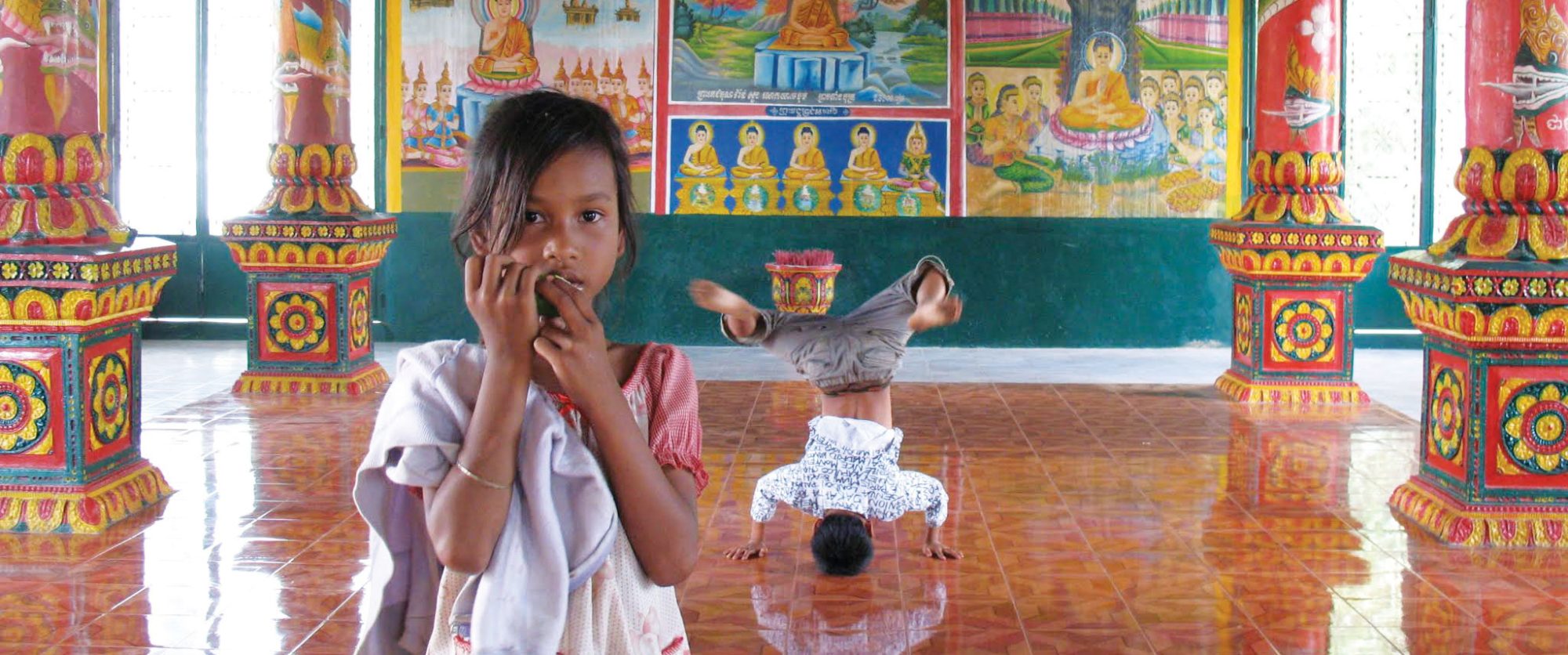The car brought her and the car left without her. Two older sisters were in the car. Srey Mom’s parents had both died of AIDS, and her sisters were supposed to take care of her. But they were pretty and young, and anxious to marry. In Cambodia the quality of a woman’s life is still largely determined by the man she marries, and it was not long before these young women realized that a promising young man, a good prospect, would have no interest in marrying a woman with a sickly young sister infected with the AIDS virus. So they brought Srey Mom to Wat Opot, a Cambodian community for children with AIDS.
Her sisters left a plastic hamper with hair ribbons and bright new clothes. Srey Mom refused to look at them or say good-bye when they left. She just stood there, very still and very small. But after the car drove through the gate and down the road past the Buddhist temple, after it disappeared down the village road toward the highway, Srey Mom began to cry. She cried for hours, cried for her mother, her father, and everything that had been lost and taken from her. She was perhaps too young to know the words for what she was feeling. She just cried.
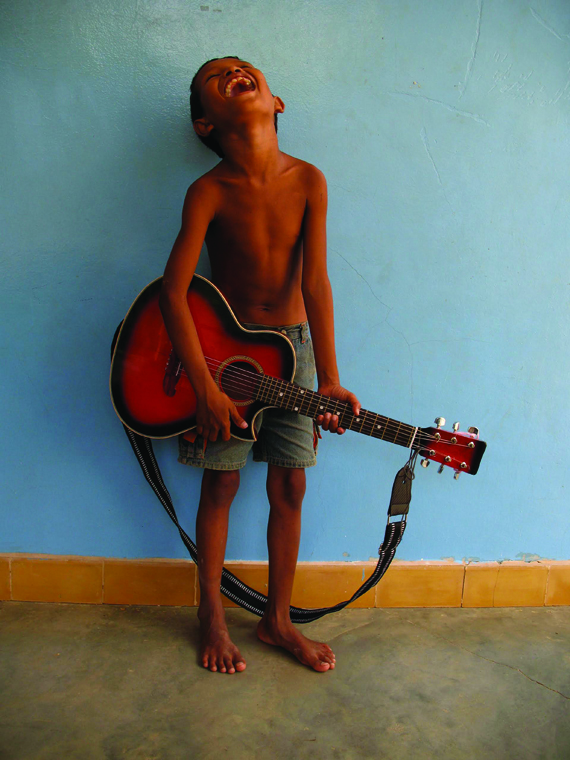
Wat Opot (a wat is a Buddhist temple, also called a pagoda) is a small village sanctuary that in 2000 donated five acres of unused land for a small project to provide palliative care to some of Cambodia’s poorest people, many of whom were dying of AIDS. The temple itself had been desecrated in the late 1970s by Khmer Rouge forces, who had used it to store corpses. The land in question was thought to be haunted.
Wayne Dale Matthysse, an American who had been a medic in the Vietnam War, began the Wat Opot Project with a young Cambodian Buddhist, Vandin San. Wayne’s first jobs in Cambodia were with the Catholic Office for Emergency Relief and Refugees (COERR), and for a small Phnom Penh orphanage. It was at COERR that he met Vandin, who was training monks to educate villagers in AIDS awareness, prevention, and patient care. One day Wayne remarked that he had seen scant evidence of an AIDS epidemic in Cambodia.
“Why would they tell you?” Vandin asked. “What do you have to offer them?” Because of the fear and stigmatization faced by people with AIDS, most kept their illness a secret. “Come,” Vandin said. “I will show you AIDS in Cambodia.”
Thus began a collaboration between an American Christian and a Cambodian Buddhist that was to evolve into Partners in Compassion, an organization dedicated to caring for people affected by HIV/AIDS. Building on the donated five acres, Wayne and Vandin opened a small clinic and hospice. When COERR left Cambodia, they offered Wayne and Vandin some of their supplies and a little money that was left from their operations, and over the years the partners’ project grew from a clinic and hospice into a vibrant community for children whose lives have been impacted by HIV/AIDS. About a third of the children are HIV-positive, and all have lost at least one parent to AIDS. At any given time between 50 and 85 children, both HIV-positive and HIV-negative, live together at Wat Opot as family, along with a number of adult patients.
Wat Opot began at a time when antiretroviral medicines (ARVs) had only recently become available to treat the first generation of children with HIV/AIDS. In those days, Cambodia had one of the highest infection rates in Asia, and many children were being born HIV-positive. But things had begun to change. Médecins Sans Frontières—Doctors Without Borders—had arrived in Takeo Province in 2003, bringing the first ARV program to a simple clinic in the provincial capital, also called Takeo. It’s a small city, about an hour south of Wat Opot, with a current population of approximately 39,000 people. Very sick children who at one time would have perished in the AIDS epidemic were for the first time on medication, and they were clearly beginning to grow stronger. The problem now was how to nurture these traumatized children who had watched their parents and friends sicken and die, who might themselves have been close to death. How to convince them that with care they might grow up, go to school, live near-normal lives?
On the last day of October in 2005, three months after my sixtieth birthday, I arrived in Cambodia for the first of what turned out to be many stays at Wat Opot. Over the next seven years, I would spend almost fifteen months as a volunteer there. Wayne does not regard the community as existing only for the benefit of the children, although that is assuredly its primary purpose. Rather, he opens the gates to anyone on a journey who stumbles upon this place and feels called to linger with the children, as I did. Asked one afternoon whether there is any thread that unites the volunteers who have passed through Wat Opot, Wayne replied simply, “Loneliness and the need for touch.” Even if people show up not realizing what is lacking in their lives, when the first child comes to hug them something changes, opening them in a way they likely could not have named before, answering a hunger that many of us do not even know we have.
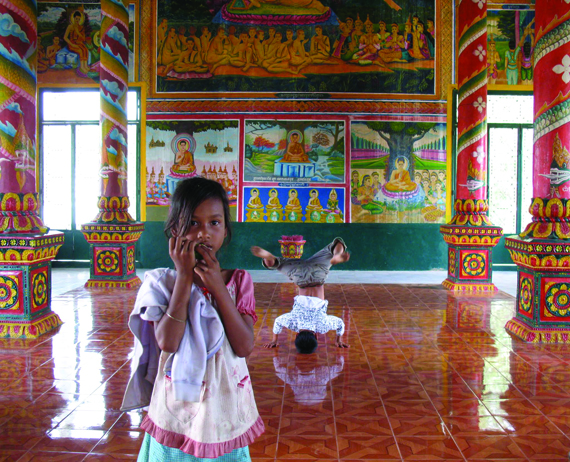
After dinner on my first night at Wat Opot, a few weeks before Srey Mom arrived, I remember walking with Wayne to the crematorium for the brief memorial service that is held there each evening. The children chant a prayer invoking the name of the Buddha and sing a Christian hymn of thanks for the lives of their loved ones.
An unruly group of kids fell in behind us on the dirt path, calling out, “Meestah Wayne go pa cha!” They shouted and sang and jostled each other, hanging in clusters from our arms and hands. I wished I had more fingers.
The crematorium—pa cha in Khmer—stands on the far eastern edge of Wat Opot’s slender strip of land. The furnace itself is in the center of the structure, and to the right of it is a tiny chapel called the family room. Inside, we crowded onto floor mats across from a wall of pictures of parents and friends who had perished of AIDS. On that first night, Wayne explained that after each cremation the children help to wash and select the bones for the little brass urns that sit in a glass case underneath the photographs. Each urn is carefully tied with a web of string and bears a tag with a name and a tiny portrait.
More children arrived and jostled into the room, tumbling and laughing. We began the service to remember our loved ones, the one simple daily practice, which is voluntary for the children yet forms the spiritual core of our days.
“Namo Tassa . . . ,” “Hail the Fortunate One,” we intoned in Pali, invoking the Buddha, “sama sam poot . . . ,” “freed from suffering, fully enlightened through his own diligent efforts.” In Cambodia this invocation begins all rituals. “Now,” Wayne said in English, “in loving thanks for the lives of our family and friends, we sing . . . ,” and the children sang enthusiastically, “Thank you, thank you, Jesus in my heart.” They punched each syllable equally, opening and closing their mouths like hand puppets, so it came out, “Tank yooo tank yooo Jeeesaa een my haaaaaat!” There followed a moment of passably silent prayer, and the offering of incense. “Ahhh-men!” they finished, bobbing the incense up and down three times—and then in Cambodian, “Satout, satout, saaa-tout!”—before they escaped and began turning somersaults in the warm evening air.
From the beginning, Wayne and Vandin San envisioned Wat Opot as nonsectarian. Wayne was a Christian and Vandin a Buddhist, and the logo they designed depicts both the cross and the Buddhist flag. Wat Opot was to be open to all, whether believers or not.
Wayne himself grew up in a neighborhood of conservative Christians, and used to be an Evangelical. (I was only the second Jew Wayne had ever known.) But he’d come to believe that when he got to heaven there would be Buddhists there, and other people of compassion. So his mission group labeled him a heretic and kicked him out because he wouldn’t try to convert anybody. They said he was going straight to hell and taking the children with him. During my first winter in Cambodia, Wayne received a letter from his own congregation in Michigan, an important source of support, informing him that they were withdrawing their funding for Wat Opot, effective immediately. They justified their boycott by saying that Wayne and his family were no longer technically members of their congregation, but to Wayne the real reason was obvious.
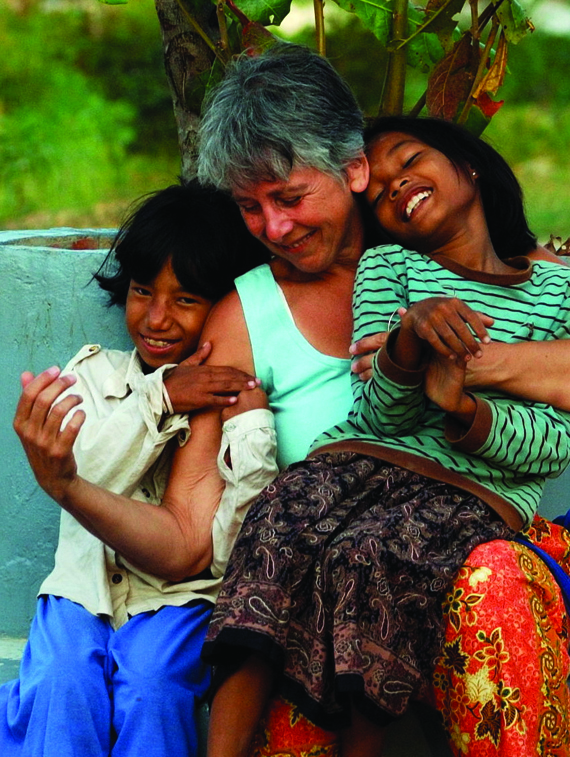
Wayne makes it clear that out of deference to the Buddhist wat, which gave the community this land, and out of respect for the Buddhist majority of the residents, any efforts to convert anyone are strictly forbidden. Still, some Christian visitors find it difficult not to proselytize. Rebecca, Wat Opot’s pediatric nurse, first met Wayne when she visited Cambodia with a Christian mission group. She could see that he needed help, and she had begun praying that he might find someone who could make a commitment to the project. After a while she came to realize she was that person. Rebecca left her job and grandchildren and moved to Cambodia and had now been living at Wat Opot for about five years.
I soon discovered that Rebecca and Wayne had serious differences over the mission of Wat Opot. Although they shared a deep love for the children, over time it became more difficult for Rebecca to accept Wayne’s refusal to proselytize. For Rebecca, bringing souls to Jesus was of overwhelming urgency, and their differences became more and more pronounced. Late into the night, sometimes for hours, Rebecca would tell me about Wayne’s shortcomings, and how the children, who knew nothing of God, only Buddha, would lose all chance at heaven. She was especially indignant about the tinsel-backed glass painting of the Buddha that hung in the hospice, right alongside a Renaissance-style image of Jesus praying in the Garden of Gethsemane.
“Jesus should be above,” she insisted. “He is so much more.”
Whenever Wayne went to Phnom Penh, Rebecca would move the picture of Jesus to a nail higher on the wall, above the Buddha, and when he returned Wayne would move it back. So it went.
I’m not sure how it came about, but at some point during my first stay at Wat Opot, Rebecca got the notion that the Pagoda Boys might be a fertile field for her proselytizing. These were kids from the villages surrounding Wat Opot who had repeatedly gotten into trouble and were sent to live with the monks. They weren’t really bad kids, but they had histories of petty theft, glue sniffing, and general mischief. In the local parlance, they might eventually become “gangstas,” small-time criminals who often as not wound up in street gangs or in prison. Wayne had set up a system for daily allowances where the Wat Opot children who attended school classes that day would receive a little spending money, the equivalent perhaps of 20 cents. No one paid much attention to the Pagoda Boys, and I doubt that the monks gave them much beyond a place to sleep and a little food, so Wayne let them line up for allowances too, and they were grateful. Though their numbers varied, there were three regulars who would show up at allowance time: Mister Ma, Mister Pa, and Mister Da.
Rebecca had always disapproved of giving money to the Pagoda Boys. They were not “our” children, and when Wayne was away she counted out precisely enough money for the Wat Opot kids but not a penny extra for the three “hustlers.”
Which is why it was such a surprise when one day she gave each boy an enormous bottle of shampoo, much bigger than our kids ever got, and instructed them to tell the monks, “This is a gift from Jesus.”
We were all having dinner the next night when the Pagoda Boys showed up, Mister Ma, Mister Pa, and Mister Da. They were completely bald. They grinned mischievously at Rebecca, put their hands together and bowed respectfully so she could inspect their freshly shaven heads, and announced, “Monks say to tell you, this is a gift from Buddha.”
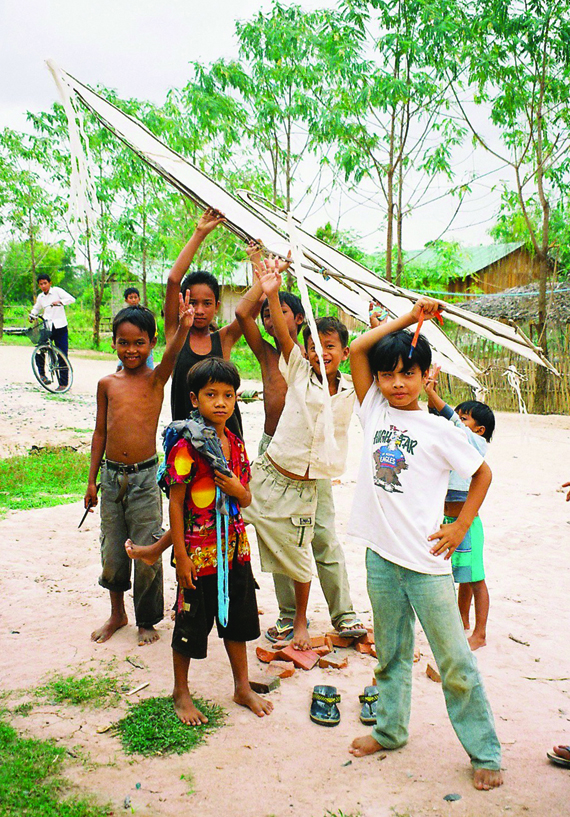
Many times that winter, during my first stay at Wat Opot, I wondered why Wayne allowed someone who undermined him and caused ill will to remain at Wat Opot, but as I grew to know him better I began to understand that his reasons were both deeply compassionate and quite human.
Except for Wayne, Rebecca was the only other fixed point at Wat Opot. Whatever their issues, he knew she would get out of bed at three in the morning to care for a dying patient, and once every few weeks, when he went off to Phnom Penh, he knew he could leave the children in her care. She was a capable nurse, and there was no one else willing to make the commitment.
Rebecca was also a determined fundraiser, and Wayne was responsible for feeding a hundred people every day. Rebecca wrote glowing newsletters that she sent to her congregation back home, and through them she raised about half the budget of Wat Opot. But Wayne told me that she kept the money from her supporters in a separate fund under her own control, and if she disagreed with him about a project, or if he did not consult her, she withheld the money. Wayne worried about how he would feed the children if Rebecca left.
The problem now was how to nurture these traumatized children who had watched their parents and friends sicken and die, who might themselves have been close to death.
As an outsider I was troubled by the incredible amount of energy we all spent worrying about Rebecca, complaining about or ignoring her unpredictable reactions, apologizing to Buddhist visitors when she refused to leave her apartment to greet them. All this took a palpable toll on Wayne’s energy, and her control over the purse strings made him feel vulnerable and angry. And that anger, unexpressed, mutated into depression. I observed to Wayne that even if Rebecca left, even if he lost her help and her funding as well, the amount of energy that would be released would more than make up for whatever she was providing, and he would find new and creative ways to take care of the needs of the community. This was to prove true, though it would take a little time and precipitate a major shift in the mission of Wat Opot.
Eventually, Rebecca began to go away frequently to work with her missionary organization. A weekend would turn into a week, and she would return, only to leave again in a week or two. Clearly, she was feeling called in a new direction. Finally she decided to leave, and Wayne took on the grueling job of tending to the needs of the entire community. For the first few months he hardly slept. Often he would spend the entire night in the hospice with a sick patient, followed by a full day of taking care of the children. There was the twice-daily regimen of medication, the administrative duties and the moment-to-moment injuries, illnesses, and personal crises of so many people, including the volunteers.
The situation came to a head when Wayne received a call from Médecins Sans Frontières asking him to take on yet another very ill adult patient who would need intensive care. Already exhausted, Wayne felt himself nearing collapse. He prayed late into the night, asking God why He was giving him more than he felt he could handle.
The next morning, Wayne announced to the long-term patients that he was closing the hospice. The hospital in Takeo had recently opened an AIDS unit, and anyone who wished to be taken care of would be transported there. For the rest, he offered an option: get out of bed, take your meals in the kitchen with everyone else, begin participating in the community, and you can stay. To a person, they got out of bed and stopped living the lives of the ill. When I returned to Wat Opot for a second winter, in 2006, I was amazed to see the same people who had been languishing on hospital cots now up taking care of children and looking much happier than I had seen them before. Wayne and the children seemed far more relaxed. A new chapter had begun.
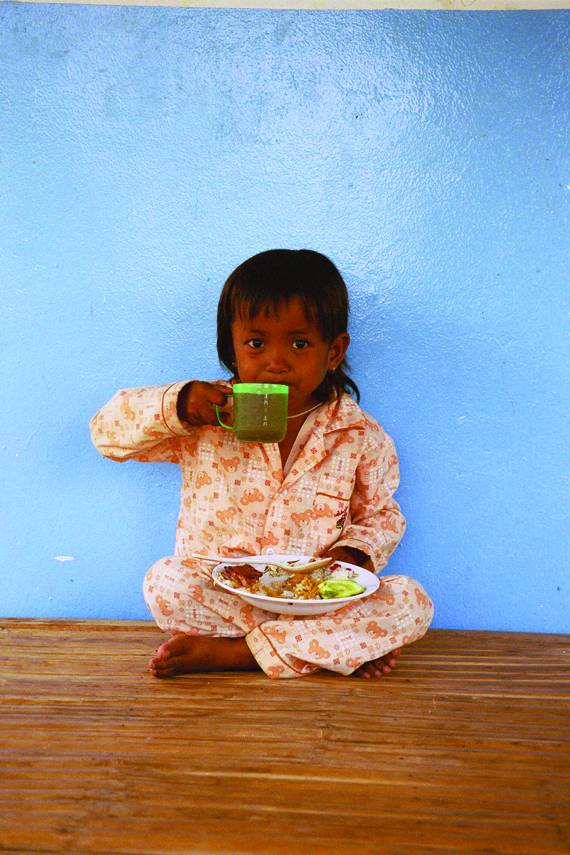
It has been over a decade now since Wat Opot opened, and Wayne seems a bit bemused to find himself father to a passel of teenagers. It is an outcome he could not have hoped for in the early days of Wat Opot, when people were dying all around him. Many of the kids are doing well, going to school, developing outside interests and friendships with people in the village. In 2013, Wayne reported that three of the children had graduated from university, two with law degrees. One boy was in his final year of civil engineering and two others were in the second year of art studies, with a third studying architecture. One was in school for midwifery and yet another in an international school of design. A few have become Buddhist monks. Five have married and are raising families, and some are now in trade schools or working in Phnom Penh. Our oldest HIV-positive boy is in high school, hoping to become a teacher. Others will soon follow.
Wayne is confronted by the problem of how to counsel young adults after they leave Wat Opot. And like many parents today, he is also faced with the phenomenon of grown children moving back home. He is beginning to reconsider the meaning of Wat Opot as a community—whether it is a place where children grow up, only to leave for the world, or whether it might offer some of them a place to settle and raise families and continue to live their lives together. For now, Wayne says he wants the community to continue to find its way, to evolve, “to become more and more itself.”
As for Srey Mom, I saw her during my last trip to Wat Opot, in 2012. I sat with the kids one night after dinner, watching TV, and Srey Mom curled up with me and went to sleep. She was 13 years old then, taller and prettier than when I saw her last, and she seemed to have grown into her face and forehead, which had always seemed large for her body. But she was still the hurt little girl I knew, and still needy, though she would shut down at the hint of a slight.
He’d come to believe that when he got to heaven there would be Buddhists there, and other people of compassion. So his heroic mission group labeled him a heretic and kicked him out.
She lay on my lap that night, took my hand and placed it on her heart, just as she did when she was younger. She had a cough. Srey Mom had tuberculosis as well as AIDS when she first came to us, and her TB treatment had caused her to weaken, giving her frequent fevers and incessant ear infections. I wondered whether she was so often in pain that she didn’t even bother to tell us anymore.
She felt feverish, but Wayne had locked himself in his office, squinting at his computer, trying to finish the annual accounting while nursing a bad cold, and I hated to disturb him. Perhaps I should have called him anyway, but Srey Mom was ready for bed and I figured she might do better just going to sleep. Standing in the twilight of the dormitory, surrounded by the breathing of sleeping children, I watched Srey Mom make up her bed. I stepped forward and helped her string up the mosquito net, defining and enclosing her own small space on the sleeping platform. Unlike the other children, especially the little ones who fall asleep in puppy piles, Srey Mom sleeps alone. She rolled out her mat. She took two pillows and placed them at right angles. Then she piled up a nest of no less than six folded blankets, these more for comfort than for warmth. Then she lay down and pulled a single blanket up over her shoulders and closed her eyes. Needing to do something, I pulled the blanket up and tucked her in, but she had already turned inward, and was gone.
Wayne told me later he has to watch Srey Mom carefully. A few times he has caught her palming her ARVs, or spitting them out when she leaves the clinic. In the end, we fear, it may not be the disease that takes her, but the sadness.
Before one of his rare visits to his family in the States a few years ago, Wayne gathered the community together to say good-bye and to reassure everyone that he would be coming back. The kids were sitting in the temple after their weekly cleanup of the grounds and the dharma lesson with the head monk of the wat. Around them were painted scenes of the life of the Buddha, and the lovely gold-papered statues smiled down at them with compassion.
“Do you know why we come here every week?” Wayne asked the children, “why we pick up the trash and sweep the temple and listen to the teachings of the Buddha and chant the lessons?”
A small voice called out, “Because you like us to?”
Everyone laughed, and Wayne answered his own question by telling the children once again the tale of how he and Vandin went looking for a place to build their clinic. How they went to many villages and wats and at each place people said they would like to help, but always there was some reason why they could not. Underneath every excuse was the same fear—fear of living near people with AIDS. Of all the places they looked, only Wat Opot, a dilapidated temple in a very poor village, gave them a small piece of land, a few parched haunted acres that was all they had to offer.
“We clean the wat every week to say thank you to the monks for our home,” he told them. “And we go to the temple to remind ourselves that we do not want to be like the people who rejected us.”
I was reminded of one Christmas party when Wayne had asked the children whose birthday we were celebrating and the kids sang out, “Yours!” I imagined Wayne and Vandin wandering about a shattered country, searching for a little land for a clinic to care for the poorest of the poor, and finally being taken in by a group of destitute monks who had nothing to offer but an abandoned field where ghosts roamed. To have watched this fragile seed flower into a thriving place where people who were near death found life and hope again and shared community—how like a miracle play that seems to me! And I am struck by how the repetition of this simple tale has all the power of a foundation myth, one that sets a standard of spiritual understanding for a people and teaches them how to live.
♦
Adapted from In a Rocket Made of Ice, by Gail Gutradt. © 2014 by Gail Gutradt. Printed with permission of Knopf, a division of Penguin Random House LLC. All rights reserved. Available in paperback from Vintage Books in June 2015.
Thank you for subscribing to Tricycle! As a nonprofit, we depend on readers like you to keep Buddhist teachings and practices widely available.
